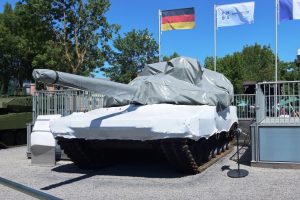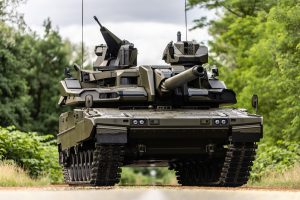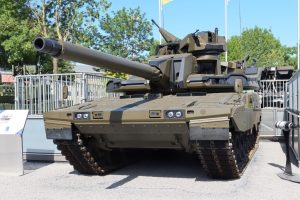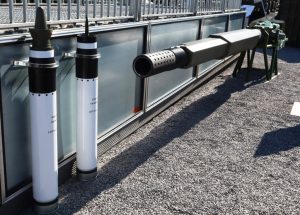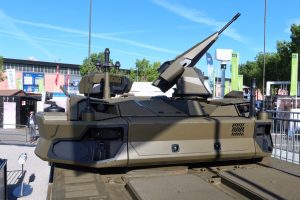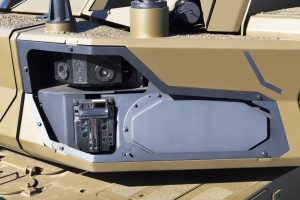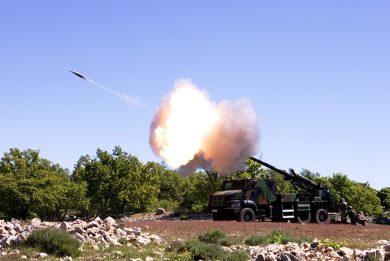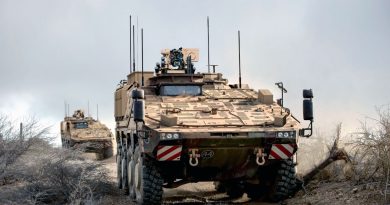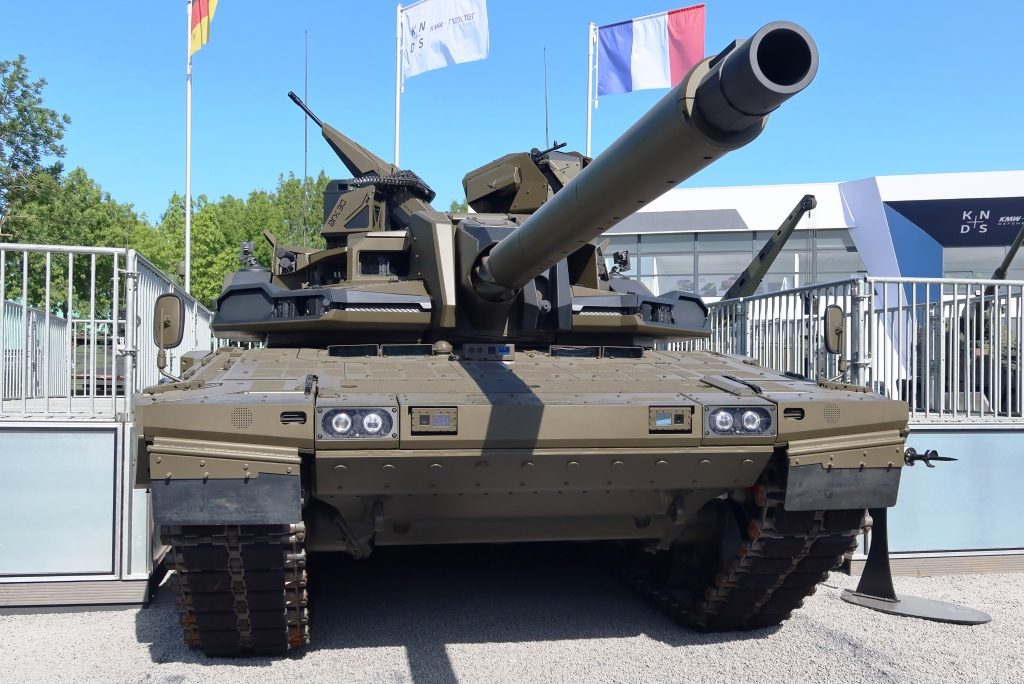
KNDS: from the Leo-clerc to the E-MBT
At the 2018 edition of the Eurosatory exhibition, the linchpin between the two exhibiting areas of the KNDS booth, that of KMW and that of Nexter, was a hybrid main battle tank made of the Leopard 2 chassis and the Leclerc turret. Dubbed by many “Leo-clerc”, it wanted to show a first cooperation between the two companies that in 2015 were put under the KNDS hat. A pure engineering exercise with no aims to become a product, the teaser generated comments from many official visitors, which were used to better focus the following step, the one that brought to the E-MBT unveiled by KNDS at Eurosatory 2022, that was kept well under wraps until the official opening of the show.
“Our aim was to show to the market what a modern MBT produced with available technologies might look like,” says Jean-Philippe Albert, the engineer who since Eurosatory 2018 took over the responsibility for the E-MBT development at Nexter Systems. The first phase of the project was devoted to a thorough and deep conceptual research which main constrains were to limit as much as possible the adoption of technologies still in development and to maintain a conventional architecture. Apart from this the development team was free to discuss on a purely industrial basis, as no potential users were involved in this phase of the process. “We took into account feedbacks from Eurosatory 2018, we considered which were the available elements, and we had to convince KNDS to invest on the project,” Mr. Albert says. With some external advices to refine the concept, this was stabilised around mid-2020.
In fact the development work was launched in parallel, even before fully stabilising the design. The main design elements identified by KMW and Nexter were mass, survivability and firepower. “We decided to keep the mass between 60 and 62 tonnes, lower than that of many current MBTs. The Leopard 2 chassis has a considerable payload capacity while the Leclerc turret is quite lighter than that of the German tank, so starting from those allowed us a considerable growth margin,” the Nexter responsible explains. “As for survivability, we considered stealthness a key issue, therefore we tried to reduce the tank height. Moreover we had to consider the increasing amount of threats coming from the third dimension,” he states. As for lethality, the 120 mm currently used on the Leclerc MBT was retained, together with the new SHARD APFSDS ammunition, which in 2018 was still in development and is now available.
One of the main discussions was about the crew. Exploiting the Leclerc gun and automatic loader the initial idea was to have three crewmembers as it is on the Leclerc. Developers came however to the conclusion that the amount of information provided by on board sensors and by the networked battlespace would saturate the tank commander capabilities. Two solutions were considered: inserting Artificial Intelligence elements, which however were considered not mature enough, or add a fourth crew member, which in the end was the one adopted.
“We then developed the demonstrator in detail therefore it cannot be considered a ‘concept car’ but it is something quite close to what might become a product, although we didn’t develop some details to the very end as we want to be able to adapt them according to customers needs. While maintaining as starting elements the Leopard 2 chassis and the Leclerc turret, we developed them in a fully integrated way, in order to obtain a fully coherent system” Mr. Albert explains. Once the design was finalised, the chassis was produced at KMWs plant in Munich while the new turret was built at Nexter’s facility in Roanne, the two being coupled together shortly before Eurosatory.
The chassis
While heavily based on the Leopard 2 automotive components, the E-MBT chassis features many differences. The first one is that it hosts two crewmembers instead of one. The driver is installed front-right while at his left we find the added position which hosts the systems’ operator. While physically installed in the chassis, “philosophically” he is in the turret, as on his working station he manages the high-end information as well as some of the effectors.
Another change is the adoption of the new EuroPowerPack made of the MTU 883 engine and the Renk 295 TM transmission, which compared to the original Leopard 2 power pack based on the MTU MB 873 Ka-501 provides the same 1,500 hp, is more compact and lighter. As the powerpack is shorter, this allowed to modify the internal layout, moving back the turret ring by about 0.2 meters, which permitted to augment the space available for the two crew members at the front, answering the issue of the increasing 95 percentile in soldiers height. According to the company moving slightly back the turret didn’t generate centre of gravity issues, as the new turret is much lighter than that of the Leopard 2. “Another positive aspect of the adoption of the MTU 883 is that this is a digitally controlled engine and therefore a drive-by-wire system could be adopted, which in perspective opens up the path to remote operation and autonomous solutions,” Jean-Philippe Albert underlines.
The chassis features 23 cameras providing different views, among which one showing the tracks in order to improve driving in urban areas. The driver and the systems’ operator can see the front scene through optical periscopes, therefore no all-digital viewing system was adopted on the E-MBT. Stereoscopic cameras are also installed, which would be useful in case of robotisation.
As for protection, that against mines and IEDs was upgraded, although no details were provided. Asked about thermal signature management, Mr. Albert answered that this issue will be taken into consideration in a further development phase.
The turret
While maintaining some common look with that of the Leclerc, the E-MBT turret is wholly new. “The concept remains, with the gunner on the right and the tank commander on the left, however their seats have been lowered as much as possible in the turret basket in order to give them a higher protection.
The turret sides are lower by around 80 mm compared to the Leclerc turret, the aim being to reduce the tank silhouette, while the centre of the turret could not be lowered, its height being due to the need to have a -8° negative elevation,” Mr. Albert explains. The work on the turret architecture was also performed with future weapon developments in mind, allowing to leverage its maturity in view of the integration of the Ascalon 140 mm gun into a future turret.
Switching to gun sights, both Nexter Systems and KMW decided that for MBTs a direct optic view channel is a must, as when dealing with targets at over 3 km the quality provided by such system cannot be replaced by optronics. The gunner has therefore an optical channel, with the optronic day/night sight beside the optical one; according to Nexter this is based on state-of-the-art elements, and is not a Military Off-The-Shelf system, the E-MBT being able to accept gunner sights from different third parties. Coming to the tank commander, he has no direct view optic and relies on the Safran Paseo commander’s periscope, which is fitted in the armed version, a 7.62 mm machine gun being installed coaxially with the sight. The machine gun can adopt a non-threatening posture lowering it towards the turret roof when operating in asymmetric situations. Scaling up lethality, the E-MBT is armed with a 12.7 mm machine gun mounted coaxially with the main gun, however before engaging a threat with a 120 mm round another option is available to the crew.
On top of the turret we find Nexter’s newly developed ARX 30 medium-calibre remotely controlled weapon station armed with the 30M781MPG also by Nexter, which is the land version of the electrically driven 30x113mm gun used on the Tiger helicopter. “This provides the tank crew with more flexibility when engaging targets of different kind, 30×113 mm airburst rounds being close to be available,” Mr. Albert states, “these ammunition being effective not only against infantry but also against drones, and in the future a radar could be added to the current optronic suite to the ARX 30 in order to give it a full C-UAS capability.” The ARX 30 is controlled by the system operator in the chassis. While the turret hosts 22 120mm rounds ready to fire; “the ARX 30 with its load of 150 rounds can take over many of the targets for which 120 mm rounds were an overkill, hence ensuring a more proper use of main gun ammunition. Moreover with its 60° maximum elevation the ARX 30 becomes a key effector in urban situations,” Jean-Philippe Albert notes.
The Paseo in the weaponised version and the ARX 30 have been fitted on the roof along a diagonal going from forward-left to rear-right, the Metravib Pilar V acoustic sensor being also along that line. “We studied the best layout in order to minimise dead angles and keep visibility in the most important sectors, and we came up with this solution,” Mr. Albert explains.
The E-MBT vetronic is heavily based on that of the Jaguar 6×6 reconnaissance vehicle, which is of course much more modern than that of the Leclerc, which development dates back over three decades. The fully digital vetronic architecture ensures that all crewmembers can recall on their displays the images acquired by the many visual sensors available, providing optimal situational awareness. “The crew stations are quite specific to the crewman role, therefore there is not much commonality between them,” the Nexter’s E-MBT Programme Manager says. The architecture allows to easily install subsystems as required by the customer. The demonstrator shown at Eurosatory last June was fitted with a standard communications suite and Battle Management System, this area awaiting further development should a customer show up, as those items are typically imposed by the user.
Another key element in an MBT, protection, is also usually developed according to customer’s requirements. Being fully developed on KNDS funds, it was pointless going too far in this area, thus for the turret the Leclerc concept was adopted, while for the chassis the latest armour package of the Leopard 2 chassis was fitted.
Apart from passive protection, the E-MBT is fitted with an active protection system, the Trophy developed by Rafael of Israel, and more precisely the Trophy MV, which provides the same protection of the former Trophy Heavy, adopted on Israeli Merkava MBTs, but with a reduced size and weight footprint, derived form what was the Trophy Medium developed for lighter vehicles. As the E-MBT turret has been totally redesigned, the Trophy sensors are embedded in the turret in a much more integrated way compared to the Trophy installation on the Leopard 2A7, where KMW had to add it on an existing turret. At the four lower corners of the E-MBT turret we find a recess that hosts not only the Trophy radar antenna, but also the sensors of the Elbit Systems ELAWS laser warning system, as well as the cameras of the Optsys 360° viewing system. The two Trophy effectors are located on the two sides at the rear of the turret, a blast shield protecting the turret itself from the rear blast when the Trophy effector is fired.
The demonstrator exhibited at Eurosatory wanted to show what KNDS considers feasible in the near term with the existing technologies of the two companies, KMW and Nexter. Some more elements can be added; notably a recess for a drone and dedicated data-link antennas were present on the tank seen at Villepinte, Nexter leveraging the experience acquired in integrating such drones in other vehicles such as the Titus 6×6. “These would allow to control the drone from under armour, the UAV being able to reconnoitre the ground up to 10 km ahead of the tank, however we have to further develop a recovery system for that drone,” Mr. Albert states.
Following Eurosatory the E-MBT started a test programme aimed at validating all functionalities, and this will mark for the time being the end of the development, awaiting a customer interested in pushing forward the concept, the work done on the demonstrator allowing to save some years in the development phase, reducing the time needed to reach production of a new MBT.
In early September 2022 KNDS released a new video on the E-MBT. Here it is:
Photos courtesy Nexter and P. Valpolini. Video courtesy Nexter

